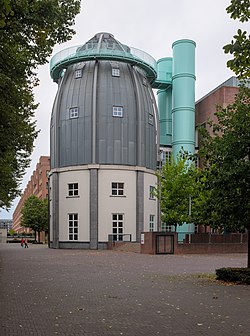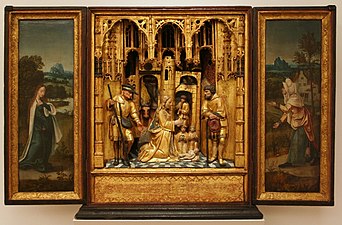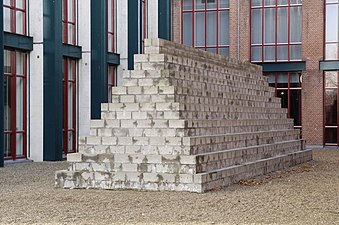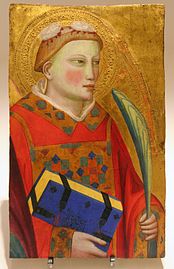History
The museum was founded in 1884 as the historical and archaeological museum of the Dutch province of Limburg. The name Bonnefanten Museum is derived from the French 'bons enfants' ('good children'), the popular name of a former convent that housed the museum from 1951 until 1978.
In 1995, the museum moved to its present location, a former industrial site named 'Céramique'. The new building was designed by Italian architect Aldo Rossi. With its rocket-shaped cupola overlooking the river Maas, it is one of Maastricht's most prominent modern buildings. [1]
Since 1999, the museum has become exclusively an art museum. The historical and archaeological collections were housed elsewhere. The museum is largely funded by the province of Limburg.
In 2009, the museum celebrated its 125th anniversary with the exhibition Exile on Main Street. In 2012, Stijn Huijts became director.
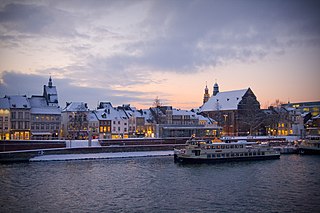
Maastricht is a city and a municipality in the southeastern Netherlands. It is the capital and largest city of the province of Limburg. Maastricht is located on both sides of the Meuse, at the point where the Jeker joins it. Mount Saint Peter (Sint-Pietersberg) is largely situated within the city's municipal borders. Maastricht is adjacent to the border with Belgium and is part of the Meuse-Rhine Euroregion, an international metropolis with a population of about 3.9 million, which includes the nearby German and Belgian cities of Aachen, Liège, and Hasselt.

Jan Brueghelthe Elder was a Flemish painter and draughtsman. He was the son of the eminent Flemish Renaissance painter Pieter Bruegel the Elder. A close friend and frequent collaborator with Peter Paul Rubens, the two artists were the leading Flemish painters in the first three decades of the 17th century.

The National Museum of Art of Romania is located in the Royal Palace in Revolution Square, central Bucharest. It features collections of medieval and modern Romanian art, as well as the international collection assembled by the Romanian royal family.

The Royal Museum of Fine Arts Antwerp is a museum in Antwerp, Belgium, founded in 1810, that houses a collection of paintings, sculptures and drawings from the fourteenth to the twentieth centuries. This collection is representative of the artistic production and the taste of art enthusiasts in Antwerp, Belgium and the Northern and Southern Netherlands since the 15th century.

Maastricht Institute of Arts, formerly known as the Academie Beeldende Kunsten Maastricht and the Stadsacademie voor Toegepaste Kunsten, is a cluster of visual arts education from Zuyd University of Applied Sciences in Maastricht. The institute offers higher education in Bachelor of Education, Fine Arts and Design, Communication Design, Architecture and Interior Design, Interdisciplinary Arts, and in Master of Scientific Illustration, Architecture and Interior Design. Since 2020, the institute, in cooperation with the Academies of Music and Theatre, the Jan van Eyck Academy and Maastricht University, has offered the possibility of a doctorate in the visual arts. The institute focuses on the meaning of art as a phenomenon in its own right, with its own insights and laws.

The Museum of Fine Arts an art museum in Ghent, Belgium, is situated at the East side of the Citadelpark.
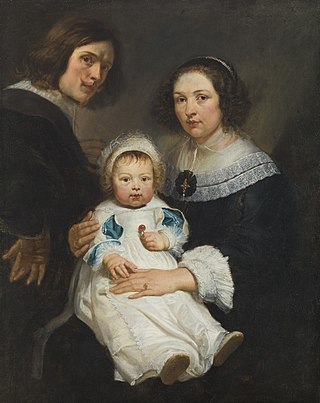
Erasmus Quellinus the Younger or Erasmus Quellinus II was a Flemish painter, engraver, draughtsman and tapestry designer who worked in various genres including history, portrait, allegorical, battle and animal paintings. He was a pupil of Peter Paul Rubens and one of the closest collaborators of Rubens in the 1630s. Following Rubens' death in 1640 he became one of the most successful painters in Flanders. He was a prolific draughtsman who made designs for decorative programmes in the context of official celebrations, for publications by the local publishers and for tapestries and sculptures realised by the local workshops. His work reveals the Classicist trend in the Baroque.

Flemish Baroque painting was a style of painting in the Southern Netherlands during Spanish control in the 16th and 17th centuries. The period roughly begins when the Dutch Republic was split from the Habsburg Spain regions to the south with the Spanish recapturing of Antwerp in 1585 and goes until about 1700, when Spanish Habsburg authority ended with the death of King Charles II. Antwerp, home to the prominent artists Peter Paul Rubens, Anthony van Dyck, and Jacob Jordaens, was the artistic nexus, while other notable cities include Brussels and Ghent.

The Van Eyck – Multiform Institute for Fine Art, Design, and Reflection is a post-academic institute for research and production in the fields of fine art, design and art theory, based in Maastricht, Netherlands. The academy was established in 1948 and was named after the painter Jan van Eyck. In 2013, 39 researches from countries around the world were working and studying at the institutes premises in Jekerkwartier. In 2012, the Hubert van Eyck Academie / Caterina van Hemessen Academie was established as a ‘teaching bridge,’ linking the Jan van Eyck Academie / Margaret van Eyck Academie with Maastricht University and other Maastricht art schools.

Gerard Caris is a Dutch sculptor and artist who has pursued a single motif throughout the course of his artistic career, the pentagon.

The Fotomuseum aan het Vrijthof is a museum of photography in Maastricht, Netherlands.
Diego Duarte or Jacob Duarte (1612–1691) was a 17th-century Portuguese jeweler, banker, composer, organist and art collector living in Antwerp, who owned paintings by Jan Vermeer, Raphael and others.

Cornelis van der Geest was a spice merchant from Antwerp, who used his wealth to support the Antwerp artists and to establish his art collection. He was also the dean of the haberdashers guild.

Maastricht silver is a collective name for silver objects produced in Maastricht, Netherlands, mainly in the 17th and 18th centuries, when the town was a major centre for silversmithing.

The Musée des Beaux-Arts d'Arras is located in the old Abbey of St. Vaast in Arras, in the Nord-Pas-de-Calais, France.
Ien Lucas is a Dutch visual artist.
The following is a timeline of the history of the municipality of Maastricht, Netherlands.

Het Noordbrabants Museum is an art museum in 's-Hertogenbosch, Netherlands.
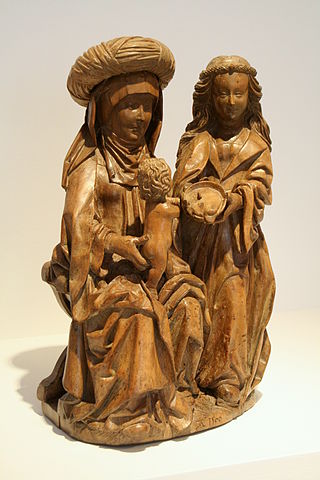
The Virgin and Child with St. Anne by Jan van Steffeswert refers to two wooden sculptures in the Bonnefantenmuseum in Maastricht, the Netherlands. One is unsigned and dated 1500, the other one is signed and dated but difficult to decipher (1511?). Jan van Steffeswert was a woodcarver from the Netherlands who worked in Maastricht in the late 15th and early 16th century.

Jan van Steffeswert or alternatively Jan van Steffenswert or Jan van Stevensweert was an Early Netherlandish sculptor and wood carver based in Maastricht. Contrary to the customs of the time, he signed at least some of the works he produced, using variously Jan Bieldesnider, Jan van Weerd or Jan van Steffeswert. To date, fourteen works have been positively identified as his.
